

Up to this point in time, I had been running a completely peaceful builder's challenge while constructing a truly absurd number of Great Walls across the map. The plan had been to continue building until reaching a Spaceship ending, only to have that thwarted by the complete lack of any Scientific IPs in the Exploration age. I had been forced to divert towards my backup plan and pursue the Military victory instead, which requires the players to conquer a bunch of settlements followed by building Project Ivy. Thus the final three dozen turns of the Exploration age had been spent rush-buying an enormous military, along with enough army commanders to ensure that they would all survive the era transition. I intended to pounce on my poor neighbors immediately and never let up the pressure until I conquered enough territory to qualify for the victory condition. Buckle up, because this third part of the report didn't end up playing anything remotely like the first two parts.
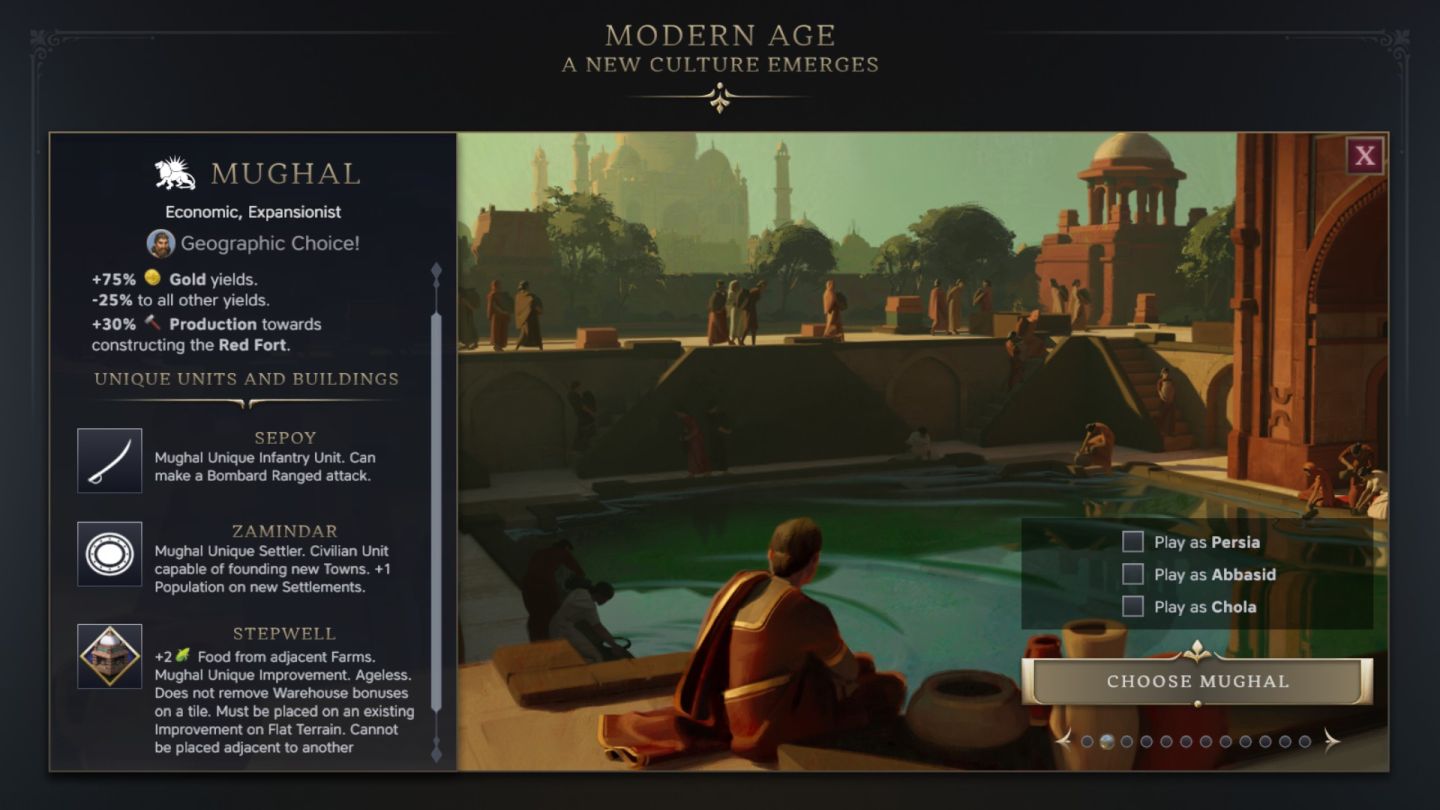
I had been looking at the different options for my Modern era civ choice and the Mughals jumped out as the most obvious pick. Forget about their various unique units and unique tile improvement, as I would never end up creating any Stepwells before this game concluded. No, I wanted the Mughals for exactly one reason: +75% to gold yields. This would give me effectively infinite money to splash around wherever I wanted and drown my AI competitors in an endless sea of military units. There was a sizable tradeoff in the form of -25% to all other yields, which wasn't great but ultimately still worthwhile to get that sweet gold bonus. There were also some nice perks in the Mughal unique civics tree (which, again, should really be visible here on the civ picking screen!) and would dovetail nicely with my pursuit of the Military victory condition.
I also made one swap to my memento choices for this final era. I continued to employ Chalcedony Seal for its +1 gold and +1 culture on unique tile improvements since I had several hundred of them scattered around the map. I'd also be getting +3 culture/gold on all of them by virtue of the innate ability of Achaemenid Xerxes for a pretty crazy total benefit. In the other memento slot, I no longer needed +1 settlement limit and swapped instead to something called Lotus Blossum: gain science and culture equal to 4% of your gold income. Typically this isn't terribly useful since even someone making 1000 gold/turn will only pick up 40 beakers and culture from the memento, with Lotus Blossum being a classic example of a "win more" mechanic that snowballs an already winning position. However, if there was ever a situation where Lotus Blossum would be worthwhile, it was surely this one with my insane gold generation and the Mughal civ to increase that number further. In particular, I was hoping that the Lotus Blossum would give me several hundred science since that was my one Achilles Heel under this variant.
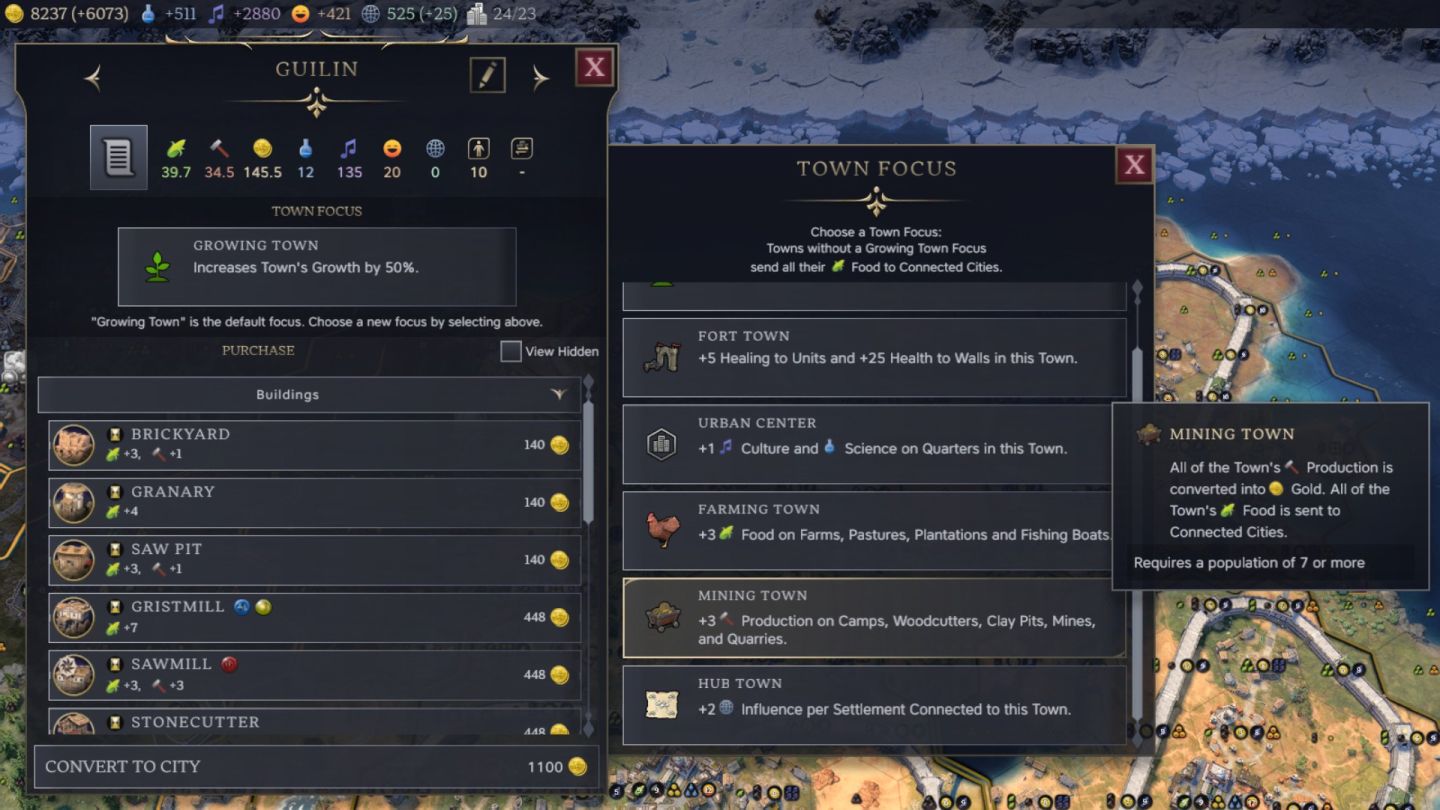
The restricted rules under which I was playing had limited me to my lowest era score total ever in the previous Exploration age. I had two Military points to spend from hitting the tier 2 scoring goal along with a Wildcard point that apparently the player always gets no matter what, that was it. Interestingly, even though I received a Wildcard legacy point, I was only allowed to spend it in the Military category because I had failed the tier 1 scoring goal in every other category. Of course, I had also accumulated seven real Wildcard attribute points from researching all of those Future Civics so this was nowhere near as bad as it sounds. I spent my few legacy points on Land of Opportunity: +10 production for settlements in distant lands along with one more Military attribute point. I would have loved to get another increase to the settlement limit, however Fealty's +2 settlement cap only exists when starting the Exploration age and then disappears for the Modern era. Why? Civ7 puts restrictions everywhere and never explains them.
Once the era was officially underway, I went through the tedious process of reconfiguring my civ after getting control back again. Did the era transition change the size of my settlements around again? You bet it did! A couple of the settlements increased in size again (grabbing new tiles that they hadn't had before), such as Pengcheng going from size 8 to size 10. But my capital somehow DECREASED in size, from size 10 to size 6. What in the world?!  It wasn't the only settlement to go down in size either as I noticed the same thing happening elsewhere. Firaxis, please get rid of these era transitions, they are absolutely awful and are killing your game.
It wasn't the only settlement to go down in size either as I noticed the same thing happening elsewhere. Firaxis, please get rid of these era transitions, they are absolutely awful and are killing your game.

Anyway, that lunacy aside, I took the time to go through my towns and assign all of them a specialization of some kind. This was to take advantage of that Expansionist attribute point from the previous era that gave every town with a specialization +15% to all yields, increased to +30% for distant lands towns. I tried to pick the Hub Town option for any towns that had a decent number of trade connections since this was one of the few ways that I could generate additional influence. Hub Town has been viewed as by far the best town specialization choice for some time now, enough that it's getting nerfed down to 1 influence per connection in the next Civ7 patch. Unfortunately I had a problem here: every single one of my distant lands towns had no connections at all, thanks to them lacking Fishing Quays to connect back to the home continent. Thus I gave all of them the Mining Town specialization, which is also quite strong by drastically increasing their production and converting that over to gold. A whole bunch of them had more than 100 production/turn after I gave them this specialization, production which turned into gold and then into science and culture via the Lotus Blossum memento.
All told, once everything was done I wound up with an income of 9300 gold/turn on the first turn of the Modern era. The comparison with the other AI empires was downright hilarious since I was making more than seven times the income of the other five leaders combined. My culture remained absurdly dominant as well and I went ahead and queued up multiple civics to see if I could discover more than one in a single turn; Civ7 actually does allow this as I picked up two civics on the next turn, nice. Once again, I was pleased to see that I was producing roughly triple the science of any other leader despite my variant restrictions and not having anything that actually generated beakers. Lotus Blossum was worth close to 400 beakers/turn here which was surely doing most of the heavy lifting. Now again, this was a game where I was abusing bugs and not really comparable to a normal game... but shouldn't the AI performance have been at least a little bit better than this? Up to this point, I had never fought anyone and limited myself to peacefully settling across the map. Surely they shouldn't be *THIS* far behind when playing on the highest difficulty, right?
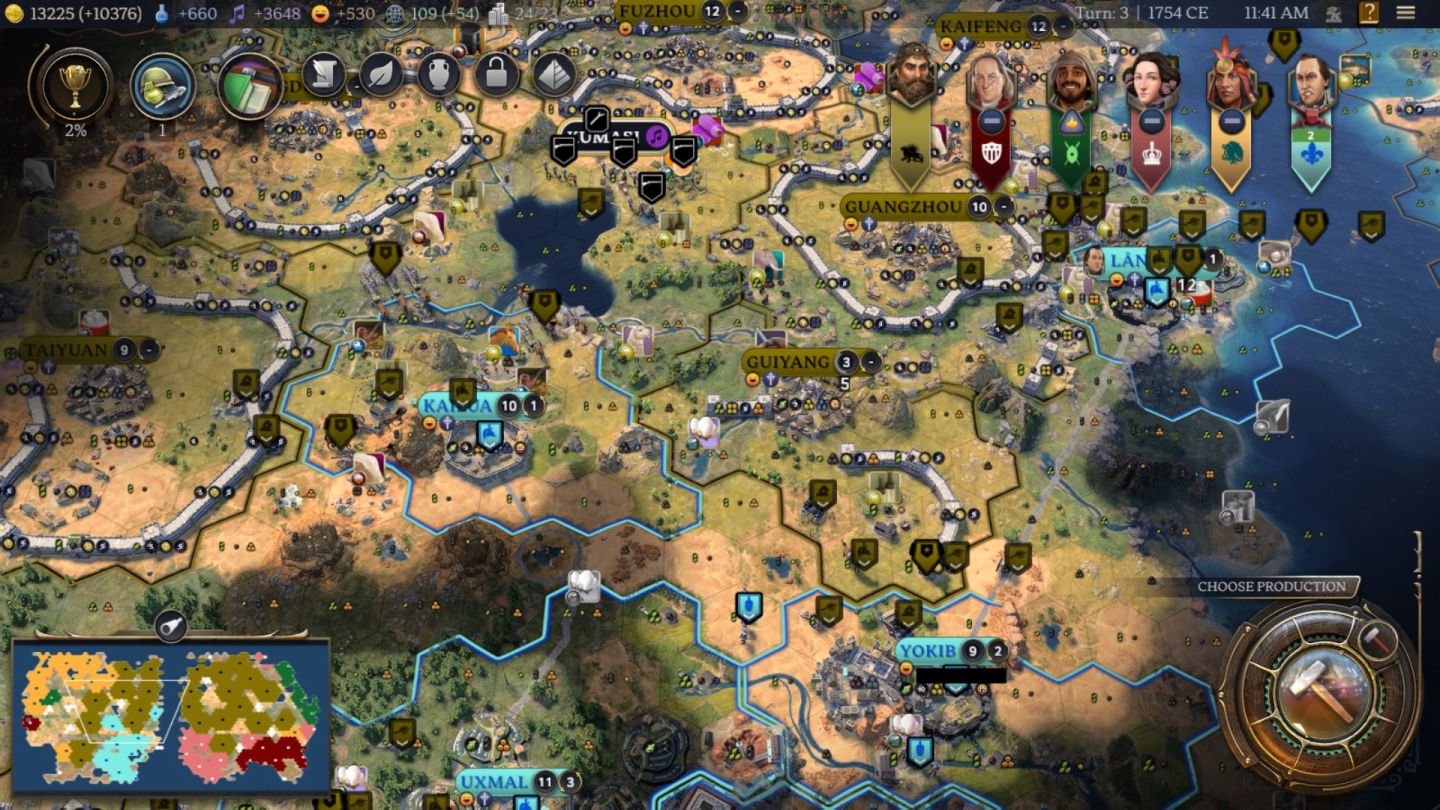
Like I said, up to this point I had played a completely peaceful game and left the AI civs alone to do whatever they wanted. That was about to change, however, and change in a massive way. I took the time to sort out where all of my units were located after the era transition (why don't they just stay in place?!) and began moving them towards my borders immediately. I wasted no time and declared war against Lafayette on Turn 3, eating a war support penalty due to this being a Surprise War which was fortunately countered by having built the Gate of All Nations (+2 war support on all wars) back in the Ancient era. If the tacticians among you were wondering about where my attack was focused, the answer was simple: everywhere. I had enormous numbers of units left over from the previous era and I was rush-buying a new unit every turn in every settlement. Even under those conditions, I still couldn't spend all of the gold building up in my treasury as it was literally not possible to spend 10,000 gold each turn. Civ7 players figured out early on that every army commander allows the player to carry an additional four units across the era transition and I had leaned into this by purchasing about 20 of them in the previous age. It's a good example of how the whole "era reset" concept can't ever be balanced properly, as either there's a true reset and everything the player does in the previous era becomes worthless, or else it's a soft reset that accomplishes nothing as in this game here. Those hordes of units were all racing to the borders now and pouring into French territory in a veritable flood.
Therefore assaults were happening all across the frontier, from Lanai in the east all the way to Paris offscreen in the west. It felt a little bit like those operational maps of the Eastern Front in World War II, enormous numbers of units advancing forward together in mutually supporting columns. I wanted to act fast and overwhelm Lafayette before he had time to start rushing out defenders; with this only being Turn 3, he clearly didn't have much of anything guarding his border cities. I was slowed a bit by my army commanders all having zero promotions which prevented them from being able to pick up and drop off units at no movement cost. I always, always take that promotion first on army commanders but with none of them having any experience yet it did make for some delays.
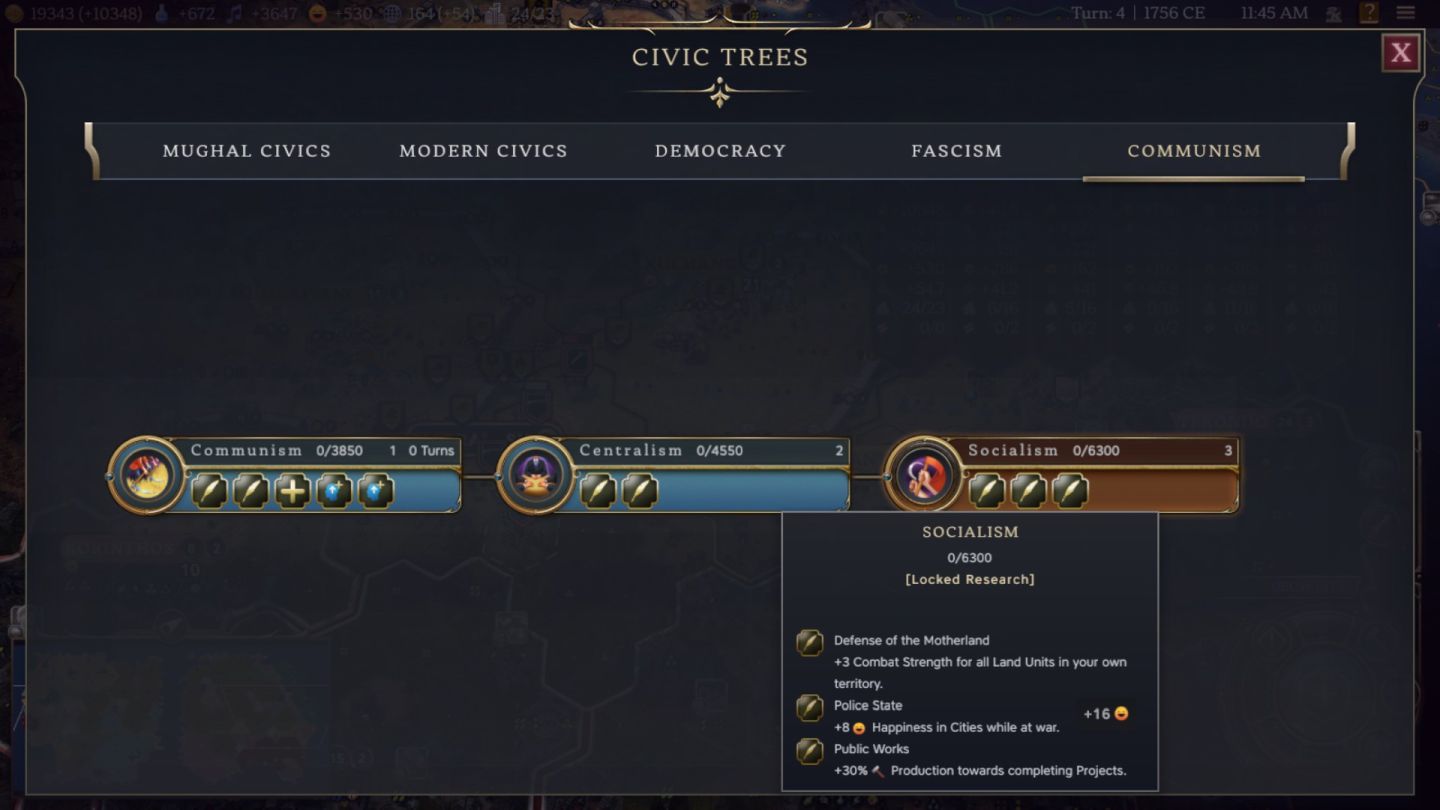
The Military victory condition in Civ7 is inherently tied to the three ideology trees that can be researched using culture. To achieve the victory condition, the player must accumulate 20 military points by capturing enemy settlements. A normal capture is only worth 1 point, a capture after adopting an ideology is worth 2 points, and the capture of an enemy settlement that practices a different ideology is worth 3 points. Unfortunately scoring the 3 points wasn't on the table here, since it relies on the AI empires adopting an ideology and they are painfully slow to do that, often taking 30-40 turns to reach that point in their civics research. Instead I was targeting the 2 point captures from having my own ideology, which would require 10 total settlements taken to win. My awesome cultural output allowed me to unlock an ideology as soon as Turn 4 and I decided to go with Communism for this game. The main reason was that final policy at the end of the Communism tree: Public Works would help me construct the final project faster, plus I could get some value out of Defense of the Motherland when fighting in captured territory after it flipped to my own borders. I though this was more useful than Fascism's Scorched Earth policy (+3 strength for units when attacking) and besides I'd already used Fascism in too many other games anyway.
With my ideology in hand, I was ready to start capturing settlements to score those military victory points. Lana'i was the most exposed French city and the first to fall on Turn 4, which brought a new conundrum: what to do with captured settlements?
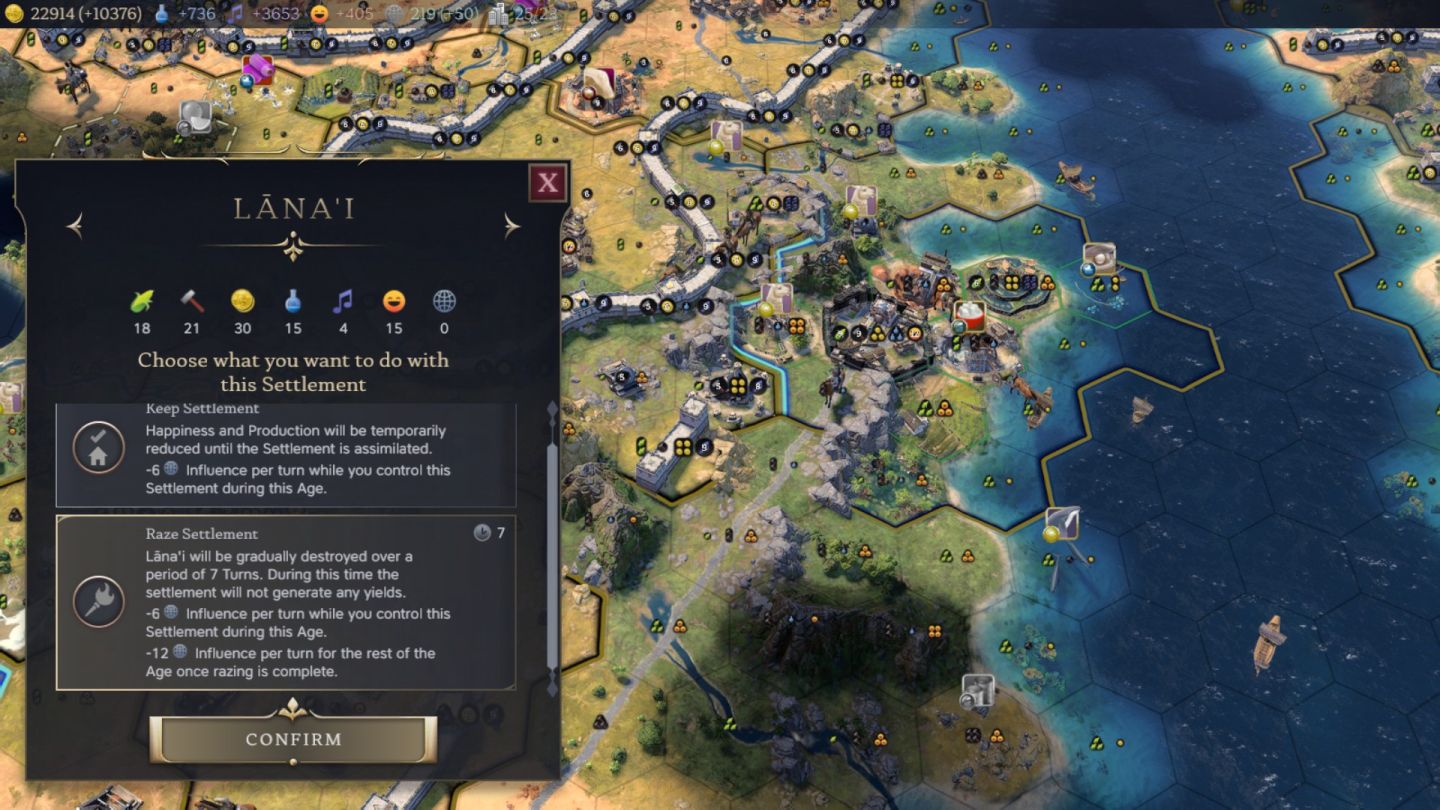
Under my variant, I couldn't keep anything that I captured since they would all have urban buildings present. I suppose that I could have kept a brand-new town which had nothing but rural tile improvements but that seemed unlikely to find here in the Modern era. This was also why there had been no point in fighting wars in earlier eras: anything I captured would have required razing anyway, making it far more profitable to focus on peaceful expansion instead. Therefore I had no choice but to raze everything, starting with the unfortunate Lana'i. Razing is an extraordinarily slow process in Civ7 that requires one turn for every population size in the settlement. That would be 7 turns here in little Lana'i but I've seen take as long as 40 turns elsewhere for huge cities. 40 turns!!!  The whole Modern era takes less time than that. It's ridiculous and basically makes razing anything of any size impossible in this game. I have no clue what the developers were thinking here.
The whole Modern era takes less time than that. It's ridiculous and basically makes razing anything of any size impossible in this game. I have no clue what the developers were thinking here.
There are also significant penalties in terms of influence associated with razing settlements. Capturing any settlement in any era decreases the player's influence for the rest of the era and there's no way to avoid this or mitigate it in any way. This influence penalty is finally explained in-game thanks to the most recent patch; before that, there was no indication whatsoever that the player was losing influence on settlement captures. Razing a settlement doubles this penalty after completion and again there's absolutely no way to remove this. (It was even worse in earlier patches, where every razed settlement caused -1 war support for the rest of the age, ugh!) I knew that this would result in my civ losing all of its influence and therefore I was on the clock to win quickly before my influence went negative. What happens if the player has zero influence and continues losing more influence each turn? I had no idea but I didn't want to find out.
One nice tidbit about razing enemy settlements: note that the captured settlements generate no yields during the razing. I could remain pure to my "no buildings" variant, getting zero benefit for any urban tiles that might be present. Rural tile improvements only!

While the AI is a moron in Civ7, it's still difficult to invade them on the top difficulties due to a combination of three factors. One is the cheapness of units: units are significantly less expensive to build in Civ7 as compared with Civ6 which makes it trivial for the AI to flood their territory with units when they come under attack. Powered by the production bonuses that they get on Deity, they can essentially 1-turn a new unit in every city every turn. This combines together with the second factor, the One Unit Per Tile rules, which make it difficult for the attacker to force objectives. Since units can't stack together outside of the use of army commanders, it's way too easy for the defender to clog up offensive operations where there simply isn't enough room on the map for the attacker to bring their full force to bear. I've been making this complaint for 15 years ever since Civ5 came out and it still remains true, if anything even worse in this game because units are cheaper and there's no corps/armies from Civ6 to combine them together.
But it's the third of these three factors that truly makes it hard to invade the AI in Civ7: they get a MASSIVE bonus of +8 strength in every single combat on the top difficulty. Civ7 uses the same combat mechanics as Civ6, under which it's the difference in combat strength between the two units that determines damage dealt and damage taken. Two units at the same combat strength will deal 30 damage to one another, with a range of potentially 20% in either direction depending on the exact dice roll, for 24-36 damage at the two extremes. However, as the gap in combat strength between the two sides increases, the unit with the advantage starts dealing more damage while simultaneously taking less damage. The +8 combat bonus on Deity difficulty is enough all by itself to swing an otherwise even combat up to 41 damage dealt against 21 damage taken. At +15 strength advantage, that further increases to 54 damage dealt against 16 damage taken, and so on with things getting worse and worse for the unit on the losing side of the combat.
This is a huge problem and the only way that I could offset this disadvantage was through crushing weight of numbers. In this mortar vs cuirassier combat, for example, I was working at a -32 strength differential which mathed out to about 8-9 damage dealt per shot. Meanwhile, that same cuirassier had enough damage to one-shot the mortar, with the average attack dealing 100 damage for ths instant kill. I had a small bonus of +2 strength due to spending influence on war support, however this was more than offset by Lafayette running the Authoritarianism government celebration that added 3 strength to all units. I should have taken this government as well but I'd never used it before and honestly didn't even know that it existed. Then he also had another 3 strength from "poison", which is a Mayan unique tradition that's supposed to add extra combat strength against damaged units and was clearly bugged here. The cuirassier was the damaged unit here, not my mortar! Anyway, it all meant atrocious odds in every combat and the need to gang up against each opposing unit. I had to use at least half a dozen ranged shots to kill every enemy unit which was only viable due to having such a gigantic numerical edge.

Lafayette wasn't the only target of my aggression as I was simultaneously launching a war against Ibn Battuta on my home continent as well. I had judged that he looked weaker than Ada Lovelace while Franklin's territory wasn't accessible from a geographical perspective. I might have done better to snip off some of Ada's scattered colonies rather than attack Ibn Battuta since the four cities that he did have were concentrated together and able to reinforce one another. This attack was also made more difficult by Battuta denouncing my military presence on his borders and presenting me with a diplomatic ultimatum: I was forced to declare war immediately or else renounce any aggression for the next 10 turns. This forced me to attack before I was entirely in position which slowed the wider advance, getting less of the unexpected cheap shot punch that I had achieved against Lafayette.
This push forwards was also hampered by rough terrain and a lack of my own settlements for support. I had rolled right through the border cities of France because I had several of my own settlements right next to Lafayette's territory, making it easier to maneuver along my roads and cash-rush a continuous supply of reinforcements up at the front lines. By contrast, the terrain along the Ibn Battuta border was heavy on rocks in the north and jungle in the south. I should have brought at least one settler along in the north to provide another place to cash-rush more units, and which would have created a road back to my other towns for faster movement. I realized this eventually and brought a settler over to the empty patch of terrain west of Kampala but there's no question that I could have been more efficient here. Ibn Battuta's resistance was tough enough that this front was more of a grinding war of attrition rather than a series of lightning conquests.
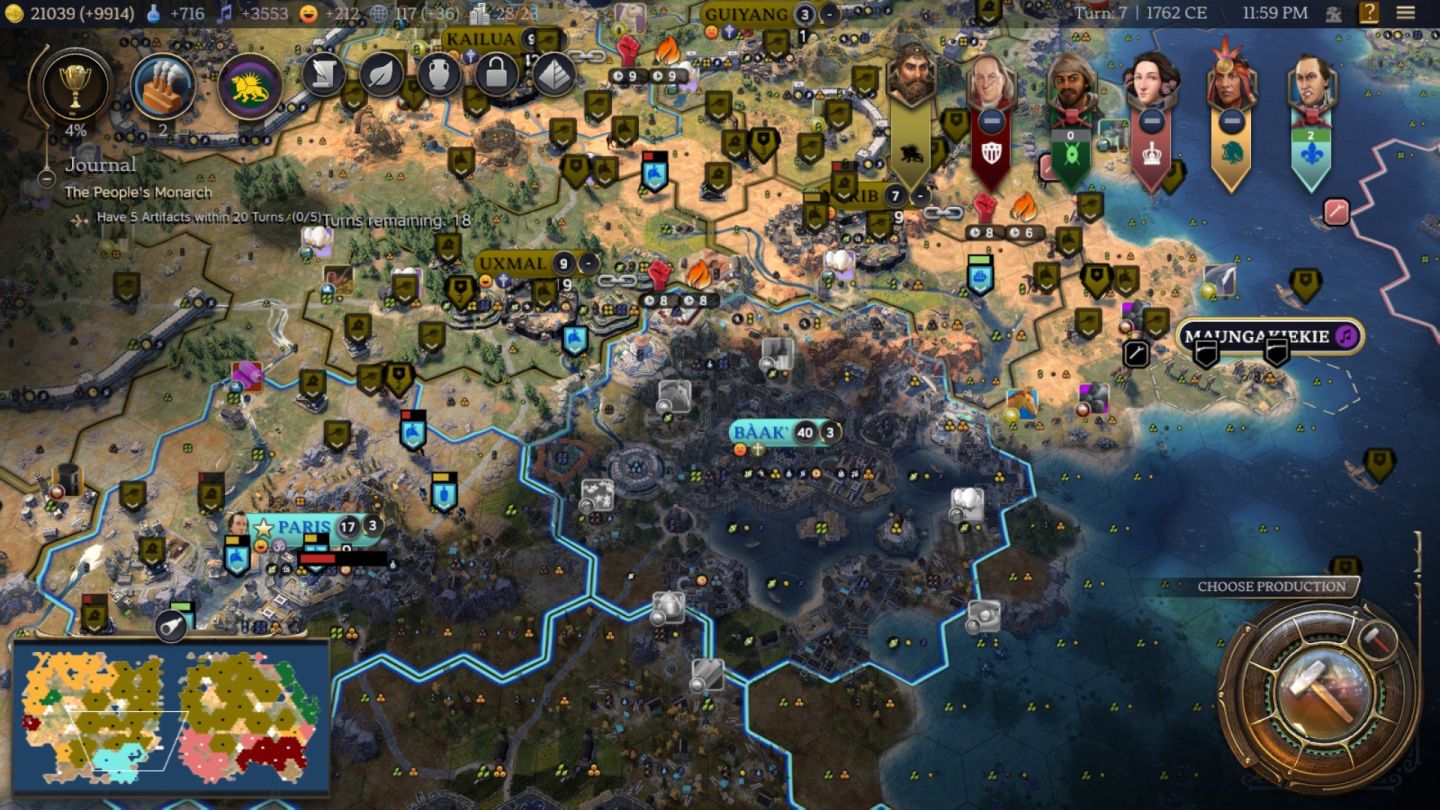
I was having more success over on the French front where the wider spaces allowed me to stretch out Lafayette's defenses and cut down his cuirassiers in isolation. Those horse units were true terrors with their base 55 strength (it still doesn't make sense why Civ7's mounted units are superior to its infantry units in every way) and I would frequently experience a cuirassier popping out of the fog to one-shot a defending field gun, followed by concentrating six or seven shots on my turn to take down the beast. At the time of this picture five turns into the conflict, I had already seized control of every French border city. Lana'i, Yokib, Kailua, and Uxmal had all been placed on the bonfire pyres and I had a couple of settlers already moving into position to replace them once they had completely burned down. Things were getting harder at this point as Paris and Baak both had significant terrain defenses to overcome and Lafayette was starting to concentrate his defenders better as the front shrank down to a smaller size. I had a trio of army commanders looking to make an amphibious landing in his back lines to help out; if only I could have built ships, this would have been a lot easier!
In terms of research, I previously mentioned how I raced to unlock the ideology trees first so that I could score 2 military victory points on each settlement capture. After that, I was proceeding through the Mughal unique civics tree and only then would I return back to the main tree since there wasn't much which would help me. Techwise, I was focusing on the bottom of the tree since that's where the tier 2 units can be found in the Modern era. Thus I began with Military Science followed by Industrialization, with the latter tech holding the tier 2 ranged unit and the tier 2 siege unit. Upgrading my field cannons and mortars would help me out enormously, as having 5 more strength in every combat makes a huge difference under the combat mechanics. I was confident that I could reach these units before any of my opponents unlocked them, and hopefully they would help improve my fortunes at the front lines.
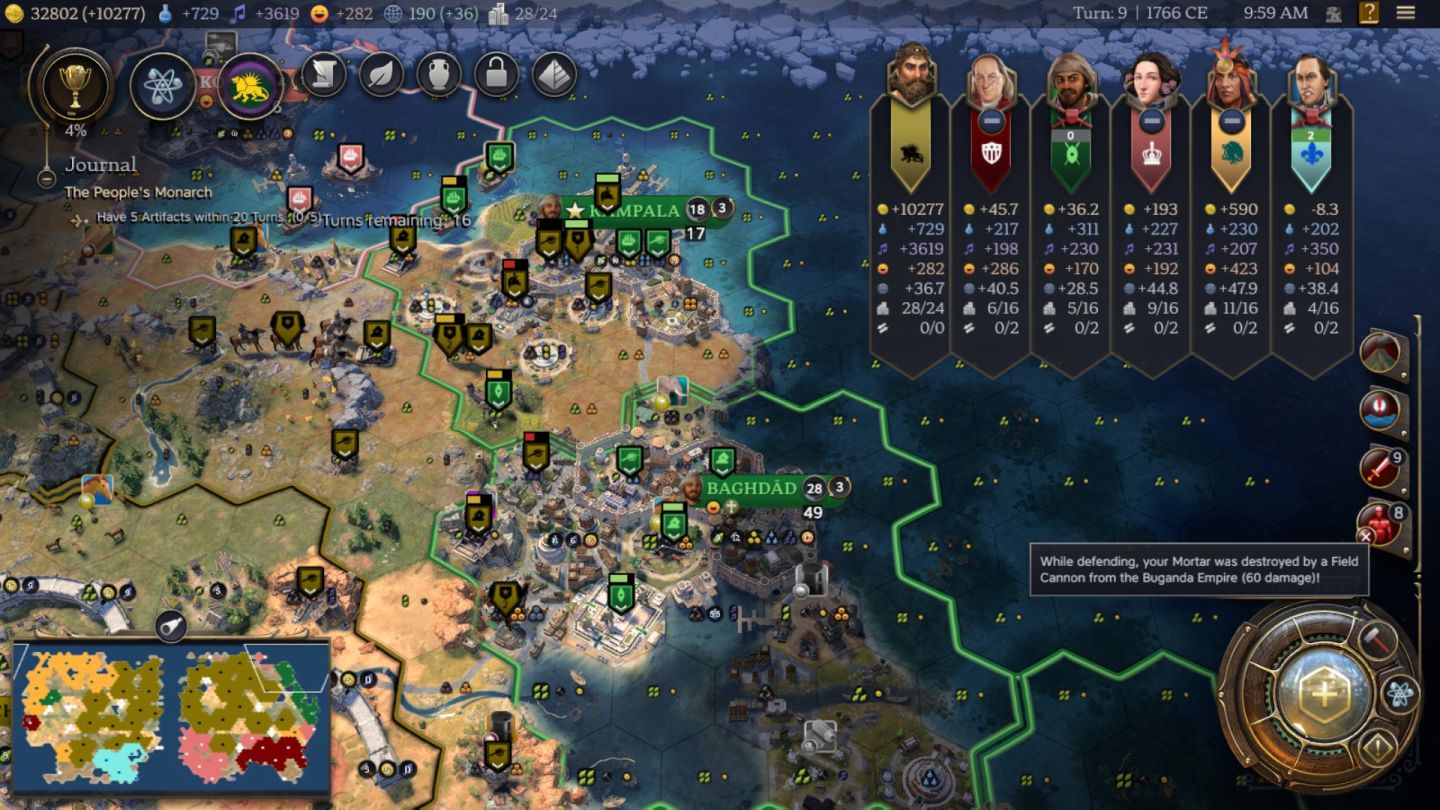
There was no mistake about it, the fighting was absolutely brutal on many of these interturns. Note that on this particular turn I lost no less than eight units and that was not at all unusual; I think my worst turn saw me lose nine units across the map. Casualties were worst against Ibn Battuta as I simply couldn't get the reinforcements up to the front lines fast enough. When he began deploying Ships of the Line to harass me on the northern seas, I began to wonder if I would be able to capture any of his four settlements or if this had been a massive strategic blunder. Things were so bloody that my entire offensive against Baghdad ended up being nothing more than a diversion, the constant stream of units that I was sending over there dying only for the purpose of tying down some of Ibn Battuta's Bugandan units. I would not have wanted to be a soldier in this Mughal army, let me tell you.
For all of the slaughter though, I was making slow progress on this front. I was attacking simultaneously at all four of Battuta's settlements and even though he was able to wipe out my central pushes, my units were having more luck advancing in the north and in the south at the edges of his territory. I was drowning Ibn Battuta with endless waves of units and it clearly was hurting him, just look at the pathetic gold/turn income of him and Lafayette in the screenshot above. Even the Deity AI starts to run out of resources eventually when facing this kind of constant pressure. Another big turning point came when I discovered Industrialization tech on the pictured Turn 9. I had essentially infinite funds to upgrade my existing units and now all of the newly cash-rushed units (which were still popping out every turn without fail) would be field guns and howitzers. It was a very big deal when an enemy cuirassier attacked and dealt 70 damage, requiring a second enemy attack to score the kill, as opposed to getting the prior one-shot elimination.

The other advantage which was slowly swinging the battles in my favor was the experience on my army commanders. They all started out as completely green officers since I had never fought anyone aside from tribal barbarians. The constant fighting quickly began leveling them up though, oftentimes with individual commanders getting 20 or even 30 experience in a single turn. The whole army commander promotion system in Civ7 is a neat idea, but unfortunately much of the interesting stuff goes to waste because promoting every commander down the pictured Assault line is so clearly the One Right Choice. The first promotion in this category is completely mandatory since it's the one that allows units to load and unload into commanders without using up their turn. (This should be an innate aspect of the army commanders instead of requiring a promotion.) At that point, the player might as well take the next three promotions because reaching the end of an individual promotion line allows them to take a commendation, each of which holds really powerful effects. And it's also not as if the other Assault promotions are even bad, with +2 strength to ranged units and +3 strength to siege units as the next two options in line. Those are great to have as well and it's hard to argue for anything in the other promotion lines over them.
Thus all of my army commanders always take the same promotions because they're so much better than everything else. Loading and unloading units is such an obvious no-brainer, you might as well not even bother with army commanders until they have that promotion. Then I pick up extra strength for my ranged and siege units, followed by always taking the pictured Order commendation for +5 strength on all land units. The other commendations are certainly nice to have but nothing else does as good of a job at countering the Deity AI's +8 combat strength advantage as getting that big boost from the Order commendation. Therefore filling out the whole Assault tree gets my ranged and siege units +7/8 strength in every fight, and that finally offsets the Deity advantages in full. My army commanders might have started out as inexperienced soldiers but they were learning rapidly, much like how the Union officers in the American Civil War kept getting better and better over time by learning on the job until they were able to win the war. This was my first commander to reach the fourth promotion / first commendation on Turn 11 and there were a bunch of others with the third promotion getting close to the same achievement.

This combination of the tier 2 military units, combined with army commanders that were stacking up more and more promotions, was clearly beginning to tip the scales further and further in my favor. I had stalled out a bit for a few turns after my initial blitzkrieg offensive reached its limits, only for a renewed push forward to begin around Turn 10. On the home continent, I was stymied in the central part of Ibn Battuta's territory while managing to capture his northern and southernmost cities, opening a path to flank the remaining settlements from either side. Here against Lafayette, the terrain surrounding Paris was absolutely brutal between a navigable river to the west, thick mountains to the north, and a cliff to the south. I had great difficulty moving units in position to attack this spot and most of the reduction of its defenses had come from field cannons shooting across the river. Even with all of these units surrounding the city, the actual capture was cheekily accomplished by a redlined field cannon that sailed in over the waters, heh. Lafayette was able to recapture Paris on the following turn, after which I killed his own capturing unit and unloaded a full-health field gun inside which gave me control for good.
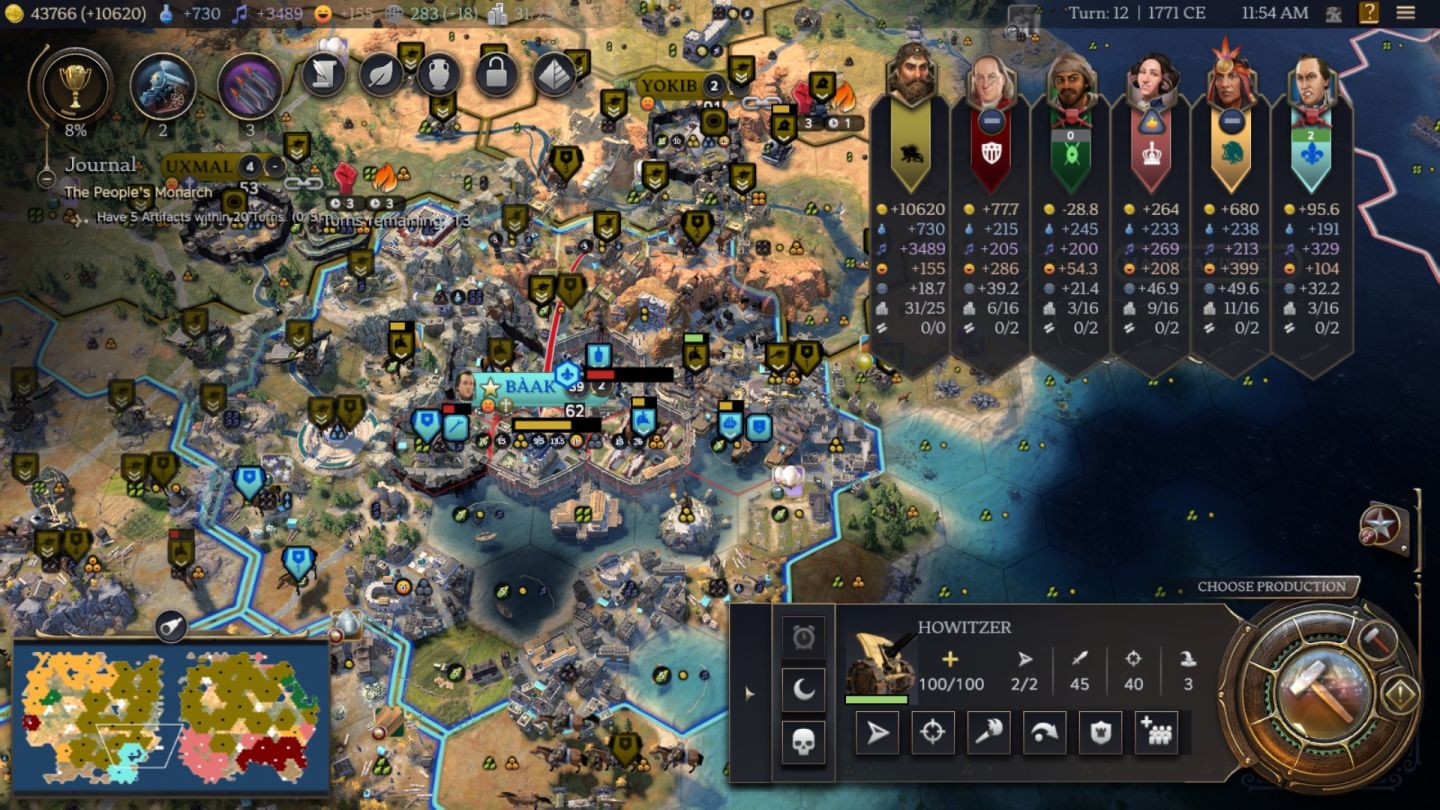
Over at Baak, it was the howitzers that were doing most of the work of reducing the fortified defenses. Howitzers are the tier 2 siege unit in the Modern era and I had been cash-rushing large numbers of them because they're the first units in the game to get an extra point of range. Even though howitzers aren't great against other units, that range of 3 makes them enormously useful since they can work around the One Unit Per Tile restrictions that otherwise clog up the map. Speaking of which, why in the world doesn't Civ7 have the corps and armies from Civ6?! They would be a massive help since units are cheaper to build in this game and hopefully would prevent screenshots like the above Carpet of Doom. I would have killed for the chance to merge three of my field guns together for +17 strength as my units kept getting choked up on top of one another in situations like this. The army commanders helped out a ton, without which it would have been almost impossible to maneuver at all, but there's no question that I was still getting stuck in traffic jams all the time. Maybe someday we can go back to a Civilization game that lets us stack units together and avoid all this nonsense, that would be nice.
Tough as his defense had been, Ibn Battuta was starting to crack as the calendar reached the end of Turn 13. As for poor Lafayette, by this date his position was about as hopeless as any that I've ever seen:

This is such a ridiculous screenshot that I don't even know what to say.  It turns out that cash-rushing a new unit in every town on every turn does produce an awful lot of units - behold the power of money! Baak was clearly about to fall on the next turn and the biggest problem that I had up there was my own units tripping over each other in their haste to get into the fighting. While that was going on, I had also finally landed my amphibious assault down by Bayeux where three fully loaded army commanders had dropped off their payloads. One of the three commanders died to Lafayette's ships (which caused the units inside to pop out), making this feel very much like a D-Day invasion. Lafayette had absolutely nothing down there and his tactical position was now hopelessly outflanked. It looked like nothing but mop-up work remaining to capture the last few French cities.
It turns out that cash-rushing a new unit in every town on every turn does produce an awful lot of units - behold the power of money! Baak was clearly about to fall on the next turn and the biggest problem that I had up there was my own units tripping over each other in their haste to get into the fighting. While that was going on, I had also finally landed my amphibious assault down by Bayeux where three fully loaded army commanders had dropped off their payloads. One of the three commanders died to Lafayette's ships (which caused the units inside to pop out), making this feel very much like a D-Day invasion. Lafayette had absolutely nothing down there and his tactical position was now hopelessly outflanked. It looked like nothing but mop-up work remaining to capture the last few French cities.
In terms of military scoring, I had taken five settlements from Lafayette and two settlements from Ibn Battuta thus far for 14 out of the required 20 victory points. I only needed three more captures in total and I probably could have gotten the remaining ones that I needed from my current opponents. I wasn't taking any chances though, and don't forget that I had unlimited money to fling around on more troop purchases. Thus I launched yet another war on Turn 13 against Pachacuti:
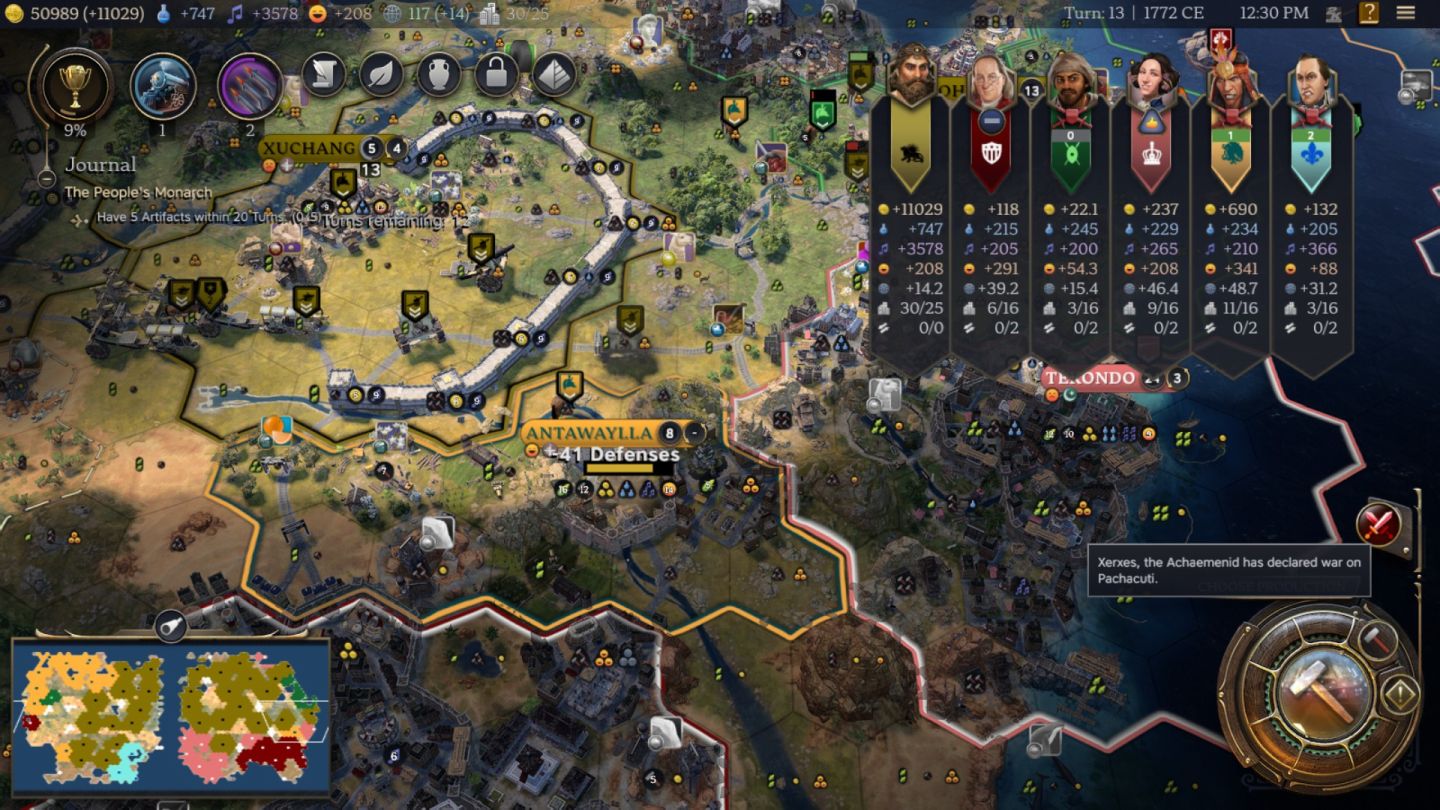
He was clearly the strongest AI leader and I had no desire whatosever to try forcing my way into his territorial core. However, Pachacuti also had several lightly defended colonies scattered around the map like the pictured Antawaylla and they would count just as much for the military scoring goal as anything else. (This is one of the dumbest aspects of this victory condition since it grants equal weight to capturing strategically useless towns as enemy core cities; at least Civ5 and Civ6 forced the player to focus on the enemy capitals.) I was targeting three Pachacuti settlements, this hopelessly isolated colony on my homeland continent along with Pachacuti's one town in the deep south of his continent and another border town right next to two of my settlements. They looked like they would be easy captures and taking all three would be sufficient to score me the remaining points needed for the military victory, even if I failed to capture anything else from Lafayette or Ibn Battuta. For that matter, I had even more units gathering for an attack on a couple of Ada Lovelace's cities though it now appeared that this wouldn't be necessary. Like I said, I had a lot of units!
The next turn saw my multi-faceted offensive advancing on all fronts. I captured the Pachacuti town in the southwest of the distant lands continent, followed by taking Bayeux and then Baak in the heart of Lafayette's territory. The French leader only had a single city remaining at Lahaina and it was under assault as well. More importantly, taking those three settlements ticked my civ up to 20 military scoring points and officially unlocked the Military victory condition. This requires the player to construct the Manhattan Project wonder and then build Project Ivy to win the game. I already had plans in mind for both of those tasks:

Remember how I mentioned that the Mughals had some useful stuff in their unique civics tree? This was what I had in mind: the final Gardens of Paradise civic contained the Mayurasana policy that discounted all purchases by 25% (not that I really needed it) along with the ability to purchase wonders with gold. This was another perfect fit for my variant setup as I was able to purchase the Manhattan Project instantly for a mere 5700 gold, not exactly breaking the bank given that I had 59,000 gold sitting in the treasury. I could have purchased all of the other Modern era wonders as well, and probably should have done so for fun even though none of them helped me militarily and that was all that mattered right now.
In any case, I was able to unlock the Manhattan Project and complete it on the same turn which left Project Ivy as the only remaining requirement. It's unfortunately classified as a project, not as a wonder, which meant that I would have to build the darn thing manually. I had been planning on this and my capital of Chang'an had been saving up production for the entire Modern era using Shift-Enter abuse; even so, it was going to take another 5 turns to finish the thing because Project Ivy is so expensive at 2000 production cost. Ah, but there was another trick that I could deploy here:

A trick that involved brutally burning down all of the independent powers on the map. This is something that I had learned about from reading posts on CivFanatics where posters were pushing for fast finishes: dispersing an independent power grants a one-time production bonus in the player's capital. I had experienced this in my own games without ever connecting this to a faster finish; there was no reason why it wouldn't work though and help speed along Project Ivy to completion. Thus behind the scenes I had been ruthlessly slaughting all of the independent powers over the past half dozen turns, killing all of their units with field guns and then occupying their central tiles so that I could disperse them on command. I had fully eight IPs ready to be razed on command, just awaiting the unlocking of Project Ivy to speed its completion. With the project now underway, I started dispersing the independent powers... only to see that nothing happened in my capital city! Huh?! I know that this works because several different people had posted about it at CivFanatics. I decided that I'd wait and try again on the next turn to see if this was some kind of bugged effect from the project unlocking mid-turn combined together with my Shift-Enter production stacking. Obviously this was not how the developers intended these endgame projects to play out!
During the remainder of Turn 14, I captured the other two Pachacuti towns that I had been targeting to bring my total haul up to a dozen settlements taken. When Turn 15 started, I figured that I would play out the turn normally and then start dispersing the remaining independent powers. First on the agenda was the Ibn Battuta front:

I was able to capture Baghdad on this turn thanks to units flanking down from the north after the successful taking of Kampala. Since I wouldn't have enough time to advance further, I signed a peace treaty at this point with Ibn Battuta and allowed him to keep his remaining two settlements. (He would have given me his colony on the distant lands continent in the treaty but of course that wasn't allowed since it would have had buildings present.) This guy was a strong ally throughout the whole rest of the game and I felt kind of bad about attacking him in such treacherous fashion. He really made me work for everything that I captured and this front was always the toughest part of the wider campaign.
Lafayette was not so lucky. With lots of maneuvering from my army commanders, I was able to get enough units in position to batter down all of the walled districts at Lahaina and then send in a cuirassier for the final blow:

Which was enough to eliminate Lafayette completely from the game. I conquered his entire civilization in just over a dozen turns which was better than I'd been expecting. I thought that I'd take all of his border cities and maybe a single core city while relying on more captures from other leaders, my units simply kept on pushing and pushing though until there was nothing left of this poor guy. I did have an awful lot of military units - that picture above might be the very definition of overkill.
With all of the fighting concluded outside of the technically still ongoing war with Pachacuti, I went back to the independent powers for a second try. My field gun sitting on top of one of their settlements clicked the disperse button, I saw a brief flash of text that read "+200 production", and then I was instantly watching the victory splash screen for a Military win. Well OK then, that was certainly abrupt. I guess that the disperse IP trick hadn't worked on the previous turn because Project Ivy hadn't been in my capital's build queue at the start of the turn or something like that. It worked on the second turn though and I was quite content to wrap up this game.

It's almost pointless displaying the final victory scoring because no one else made any progress whatsoever towards a victory condition. That's not surprising though since I did finish the Modern era on Turn 15 in what was by far my fastest ending yet. I ended up capturing 14 settlements in total which was far above what was necessary and well over half the map was painted in Xerxes' brown territory at the close of this match. There wasn't much more to say, I had successfully converted my financial strength into overwhelming military strength and then ran over two of the five competing AI empires to seal the victory. Game, set, and match.
This was certainly an interesting game. I did have a lot of fun playing it, especially the Ancient and early Exploration ages where I was going crazy with all of the wall segments everywhere. It dragged quite badly by the end of the game though (Civ7 doing nothing to solve this problem and if anything makes it worse) and my wider frustrations with the shortcomings of Civ7's gameplay only became more apparent as time passed. Mostly I felt a big sense of relief to be done with this variant concept; don't forget, this was my third attempt at the variant after doing the whole Ancient era twice with Machiavelli ahead of time. I'd been screwing around with this whole "no buildings" thing for the last month and now I could finally put it to rest. I'll probably also take a pause from Civ7 for a while and see if the developers can improve it with patches. There's some cool stuff in various parts of the gameplay but the legacy scoring and era transitions are so bad that I don't have much desire to start up a new game. We'll have to see what time brings though I'm not optimistic at the moment.
This was a long journey if you made it through all three parts of the report. Thanks as always for reading along!



